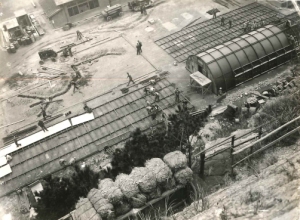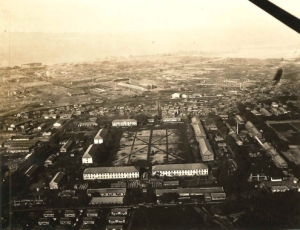Blog Archives
Sea Bees in Japan after the WWII
On V-J Day, thirteen Naval Construction Battalions (NCB), three Special Naval Construction Battalions (stevedores), and one Construction Battalion Maintenance Unit (CBMU) awaited assignment to Japan, where they were to aid naval forces at Hiroshima, Kabayana, Yokosuka, Omura, Nagasaki, Sasebo, and Kure. Their tasks included constructing, repairing, and maintaining Naval and Marine Corps bases throughout Japan to support US armed forces in occupying the country.
On 15 August 1945, Seabees with the 136th NCB embarked in 12 LSM’s at Guam headed for Iwo Jima and onto Yokosuka, Japan. They arrived at the badly damaged Yokosuka navy yard on 30 August 1945, where they established their camp at the Japanese navigation school. In preparation for the arrival of additional forces, the Seabees repaired housing, electric and telephone systems, and roads at the naval base; graded fields and remodeled buildings for the fleet recreation area; repaired housing and surfaced an airstrip at Kisarazu airfield.
Meanwhile, the 602nd CBMU arrived at Yokosuka to maintain runways and roads at the Marine Corps air base. They constructed a 2000-man galley, restored barracks and facilities for personnel, constructed a chapel and recreation facilities, completed a sawmill, public works shops, a cold-storage plant, and a chlorination plant for water treatment, and installed hot water showers in all barracks.
During the month of September, the 41st Regiment, consisting of the 9th, 28th, 62nd, and 90th NCB, and the 28th Special Battalion, joined the 136th NCB at Yokosuka. Among the major projects included repairing and maintaining the naval base at Kisarazu naval air station, which included overhauling the gasoline system and providing housing facilities for air station personnel and repairing and maintaining the airstrip. They also repaired buildings and erected Quonset huts for housing and messing facilities for port director activities at both Yokosuka and Tokyo, and loaded gravel from the Atsugi River for use in repairing roads and runways.
Sasebo on the island of Kyushu, not far from Nagasaki, was the other big center of Seabees activity in Japan. For some time, the 7th Naval Construction Regiment, consisting of 4 NCBs and the 31st Special, were working simultaneously at Sasebo to construct the naval base, clear the dock area in the navy yard and provide space for roadways and facilitating the unloading of ships. This required removal of large quantities of scrap metal, heavy marine equipment, and other debris. The Seabees used a Japanese floating crane and Japanese barges, together with some Japanese laborers, were used on the task.
In addition to repairing and maintaining the Marine Corps camp at Ainoura, the 116th NCB rehabilitated and constructed 5 miles of road from Ainoura to Sasebo, together with an alternate 5-mile stretch and operated two quarries to support road work construction. The Seabees also constructed a Quonset hut camp to house 400 men at the former aircraft factory at Sasebo. Seabees with the 72nd NCB constructed a 2000-man camp, two 200-bed hospitals, and recreational facilities in Sasebo to support naval forces.
Upon its arrival in Japan, the 31st NCB had been sent to Omura, about 28 miles from Sasebo. At Omura, the battalion was given a former Japanese hangar for temporary barracks, messing, and work space, and assigned a former Japanese garrison force compound for permanent barracks and work space. The area was deliberately destroyed in an attempt to inconvenience occupation troops; all the latrines were in disreputable condition, lighting fixtures had been torn out, and the general litter and debris throughout the area was so extensive that a 40-man cleaning crew worked for more than a fortnight removing debris and trash.
One of the most unique duties the Seabees undertook in Japan after the war ended was working on the Bureau of Yards and Docks Technical Mission to Japan to survey damage wrought by the atomic bombs and other aerial bombing attacks. This group consisted of structural engineers and Seabees sent to Japan to survey the damage inflicted by atomic bomb attacks on Hiroshima and Nagasaki as well as damage caused by high explosive and incendiary bombs.
Unknowingly, these men exposed themselves to radiation and many died young of cancer, leukemia, and unknown illnesses all in an effort to assist the US in understanding the devastation atomic bombs leveled on a major city and industrial areas, and how to build facilities in the future to withstand atomic warfare.
By mid-1946, all Seabee units stationed in Japan were disestablished and the men were discharged from active duty. The Seabees were part of the demobilization plan, and by June 1946 their number had fallen from a peak strength of more than 250,000 men to approximately 20,000. The Seabees that served in Japan, during this time, played a key role in the construction of bases, roads, facilities, and infrastructure necessary to assist Japan in rebuilding their economy and country in the post-war years.
From the SeaBee Museum.
CLICK ON IMAGES TO ENLARGE.
################################################################################################################
Military Humor –
################################################################################################################
Farewell Salutes –
Scott Bumpers – TN; Tennessee National Guard, MSgt., 118th Wing/118th Intel Surveillance & Recon Group
Clayton Eldridge – Williamsville, NY; US Navy, WWII, PTO, USS Dayton
Betty Gill – Madison, WI; US Woman’s Marine Corps, WWII
Shelli Huether – TN; Tennessee National Guard, Lt. Colonel, 118/118th Intel Surveillance & Recon Group
Russell McCauley (101) – Altoona, PA; US Navy, WWII, PTO
Casey A. Popenoe – USA; US Army, Iraq, Chief Warrant Officer 3, 2/8/1/25th Infantry Division
William Rouch – Bangor, PA; US Army / WWII historian
Robert Salgado – Palm Springs, CA; US Army, WWII, 82nd Airborne Division
David Smith Jr. – East Walpole, MA; US Navy, WWII
Jessica Wright – TN; Tennessee National Guard, Captain, 118/118th Intel Surveillance & Recon Group
################################################################################################################################################################################################################################














